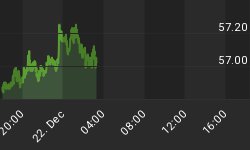Inflation has been a major topic of obsession in the mainstream investment press of late. In fact, you'd have to bury your head in the sand just to avoid hearing it discussed. A recent FT headline reads, "Fed set to keep raising rates to curb inflation" as the Fed's stated goal is to fight off the winds of inflation. But the charts suggest that inflation has already been largely tamed, as I alluded to not long ago.
For instance, the 10-year Treasury Yield Index (TNX) is currently near a 1-year low at 4.2% and below its 30-day, 60-day, and 90-day moving averages. The yield on the 5-year Treasury Note and 30-year bond have been declining as well, along with the municipal bond index.
But one of the best charts I've seen recently which shows just how contained inflation pressures are is one provided by colleague Richard Lees of Richard Lees Capital Management (www.rlcm.com). With Richard's permission, I've reproducing this chart as shown below. It reflects the actual rate of inflation to be below that of 2000-2001 and about even with that of 1997.

This chart really puts it all into perspective and shows that all the hoopla over inflation returning is overdone. Indeed, Year 2005 has been and will likely continue to be a cooling off year for most inflation-sensitive commodities and economic sectors. The global economy was in danger of becoming significantly overheated, which is why the slowdown has been engineered (as shown in the monetary aggregates).
As Richard Lees remarked in one of his recent commentaries, the same commentators who not long ago were talking about $100/barrel oil have since turned their attention to other potential super-crises (most recently Ford and GM to name one instance). Indeed, the recent spate of doom-and-gloom headlines strong suggests that the latest stock market correction has ended and a short-term bottom is in.
In one of his recent commentaries, ace economist Ed Yardeni makes reference to the slowdown in liquidity and its implication for a global economic slowdown - a needed adjustment to restore the balance of supply and demand in certain sectors. He points out that as measured by the yearly percentage change in foreign official dollar reserves, there will be less liquidity for oil. Despite soaring world oil demand, foreign official dollar reserves are down nearly 40% from almost a year ago. "The slowing in global liquidity suggests that global oil demand growth should peak soon," he writes.
Another person who shares the view that inflationary pressures are well in hand is Don Hays, who has observed that several inflation-sensitive commodities have already declined well below last year's highs, including lumber, copper cathodes and aluminum.
This abatement of inflation pressure will help some areas of the economy get a much needed breathing space and will make for some interesting trading opportunities in the coming months.















